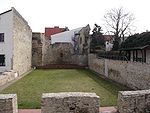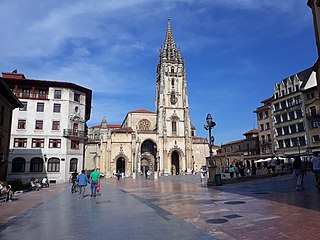
Oviedo or Uviéu is the capital city of the Principality of Asturias in northern Spain and the administrative and commercial centre of the region. It is also the name of the municipality that contains the city. Oviedo is located approximately 24 km (15 mi) southwest of Gijón and 23 km (14 mi) southeast of Avilés, both of which lie on the shoreline of the Bay of Biscay. Oviedo's proximity to the ocean of less than 30 kilometres (19 mi) in combination with its elevated position with areas of the city more than 300 metres above sea level causes the city to have a maritime climate, in spite of its not being located on the shoreline itself.

Ingelheim, officially Ingelheim am Rhein, is a town in the Mainz-Bingen district in the Rhineland-Palatinate state of Germany. The town sprawls along the Rhine's left bank. It has been Mainz-Bingen's district seat since 1996.

The Lateran Palace, formally the Apostolic Palace of the Lateran, is an ancient palace of the Roman Empire and later the main papal residence in southeast Rome.

The term Kaiserpfalz or Königspfalz refers to a number of palaces and castles across the Holy Roman Empire that served as temporary seats of power for the Holy Roman Emperor in the Early and High Middle Ages.

Carolingian architecture is the style of north European Pre-Romanesque architecture belonging to the period of the Carolingian Renaissance of the late 8th and 9th centuries, when the Carolingian dynasty dominated west European politics. It was a conscious attempt to emulate Roman architecture and to that end it borrowed heavily from Early Christian and Byzantine architecture, though there are nonetheless innovations of its own, resulting in a unique character.
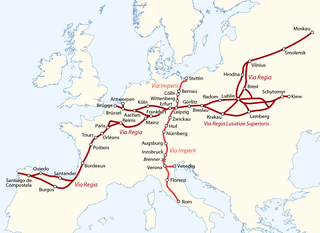
The Via Regia is a European Cultural Route following the route of the historic road of the Middle Ages. There were many such viae regiae associated with the king in the medieval Holy Roman Empire.

The Sala Regia is a state hall in the Apostolic Palace in Vatican City.
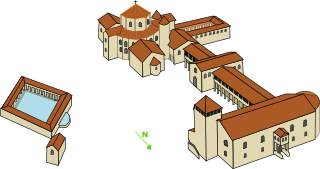
The Palace of Aachen was a group of buildings with residential, political, and religious purposes chosen by Charlemagne to be the center of power of the Carolingian Empire. The palace was located north of the current city of Aachen, today in the German Land of North Rhine-Westphalia. Most of the Carolingian palace was built in the 790s but the works went on until Charlemagne's death in 814. The plans, drawn by Odo of Metz, were part of the program of renovation of the kingdom decided by the ruler. Today much of the palace is ruined, but the Palatine Chapel has been preserved and is considered a masterpiece of Carolingian architecture and a characteristic example of architecture from the Carolingian Renaissance.

The church of Saint Mary at Mount Naranco is a pre-Romanesque Asturian building on the slope of Mount Naranco situated 3 kilometres (1.9 mi) from Oviedo, northern Spain. Ramiro I of Asturias ordered it to be built as a royal palace, part of a larger complex that also incorporated the nearby church of San Miguel de Lillo, 100 meters away. The palace was completed in 842 and had in part a religious function, being consecrated in 848. Its structural features, such as the barrel vault—with transverse ribs corresponding one-to-one with contraforts at the exterior, make it a clear precursor of the Romanesque construction. The exterior decorations, as well as the use of stilted arches, mark the intended verticality of the composition.

Giacomo Boni was an Italian archaeologist specializing in Roman architecture. He is most famous for his work in the Roman Forum.

A palas is a German term for the imposing or prestigious building of a medieval Pfalz or castle that contained the great hall. Such buildings appeared during the Romanesque period and, according to Thompson, are "peculiar to German castles".

The Imperial Palace of Goslar is a historical building complex at the foot of the Rammelsberg hill in the south of the town of Goslar north of the Harz mountains, central Germany. It covers an area of about 340 by 180 metres. The palace grounds originally included the Kaiserhaus, the old collegiate church of St. Simon and St. Jude, the palace chapel of St. Ulrich and the Church of Our Lady (Liebfrauenkirche). The Kaiserhaus, which has been extensively restored in the late 19th century, was a favourite imperial residence, especially for the Salian emperors. As early as the 11th century, the buildings of the imperial palace had already so impressed the chronicler Lambert of Hersfeld that he described it as the "most famous residence in the empire". Since 1992, the palace site, together with the Goslar's Old Town and the Rammelsberg has been a UNESCO World Heritage Site because of its millennium-long association with mining and testimony to the exchange and advancement of mining technology throughout history.

The church known as Goslar Cathedral was a collegiate church dedicated to St. Simon and St. Jude in the town of Goslar, Germany. It was built between 1040 and 1050 as part of the Imperial Palace district. The church building was demolished in 1819–1822; today, only the porch of the north portal is preserved. It was a church of Benedictine canons. The term Dom, a German synecdoche used for collegiate churches and cathedrals alike, is often uniformly translated as 'cathedral' into English, even though this collegiate church was never the seat of a bishop.
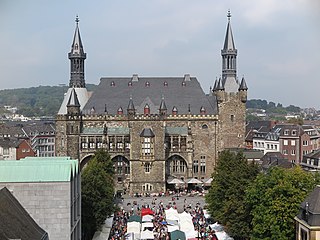
Aachen Town Hall is a landmark of cultural significance located in the Altstadt of Aachen, Germany. It was built in the Gothic style in the first half of the 14th century.

The Ingelheim Imperial Palace was an important imperial palace erected in the second half of the 8th century in Germany. It served kings of Francia and later Holy Roman Emperors and Kings as a residenz and place for governance until the 11th century.
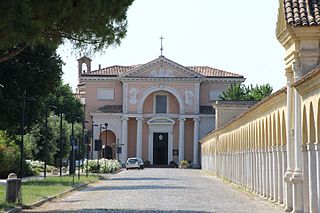
The Sanctuary of Santa Maria in Aula Regia is a Roman Catholic church located in the town of Comacchio, in the province of Ferrara, region of Emilia-Romagna, Italy.

The Imperial Palace at Gelnhausen, in German also called the Kaiserpfalz Gelnhausen, Pfalz Gelnhausen or Barbarossaburg, is located on the Kinzig river – originally on an island –, in the town of Gelnhausen, Hesse, Germany.
